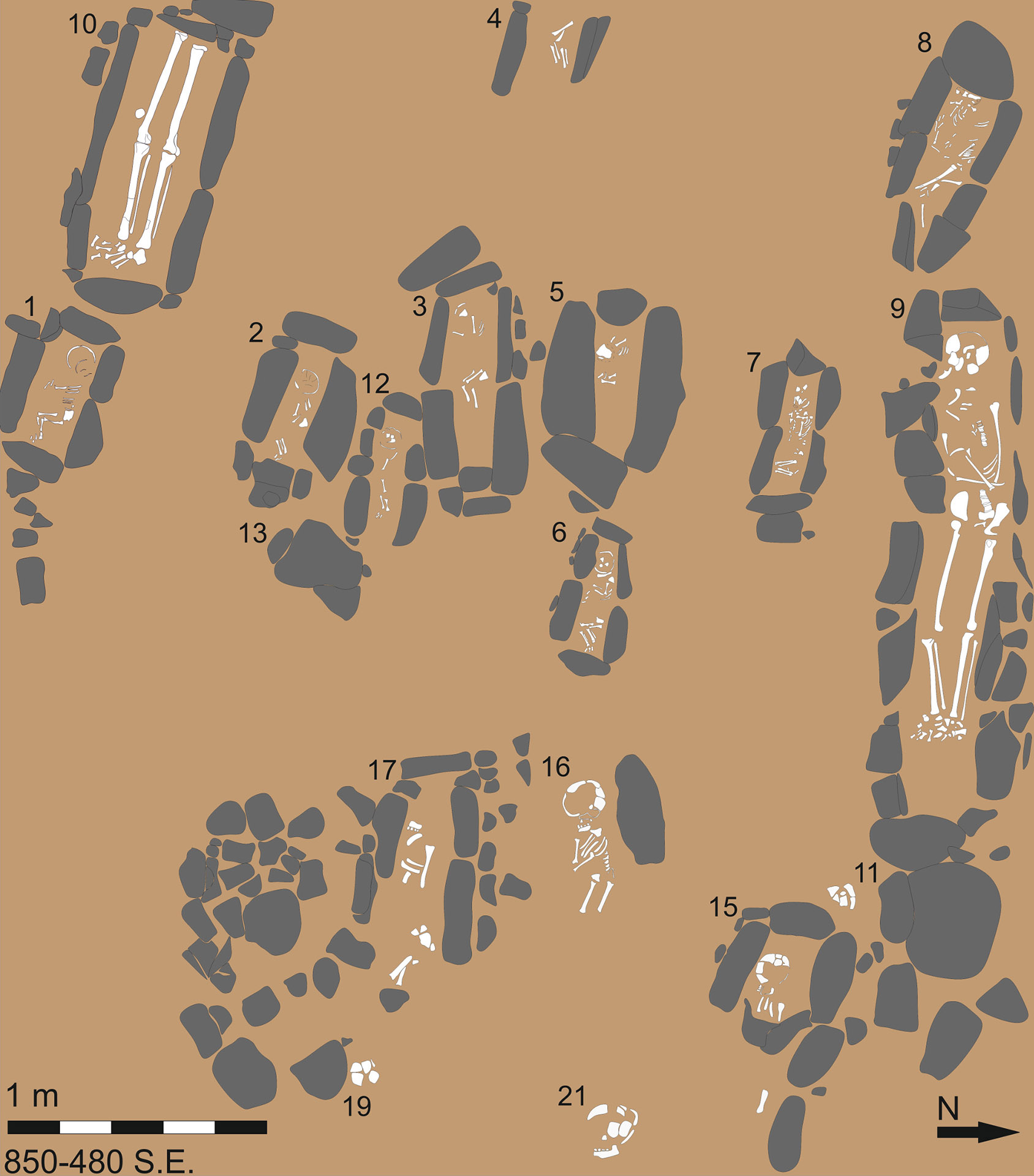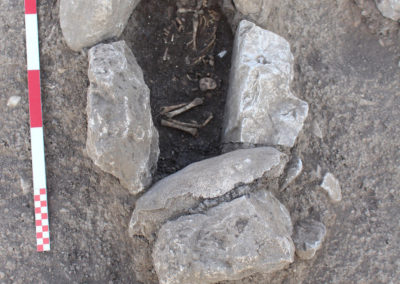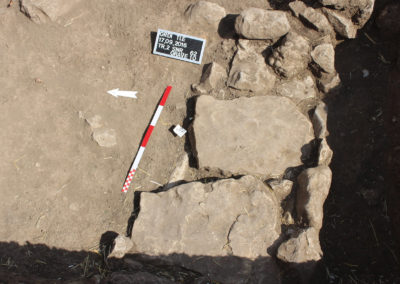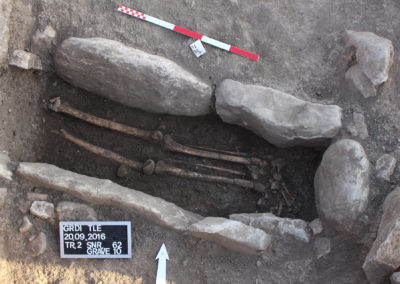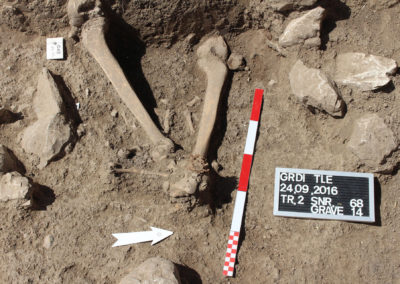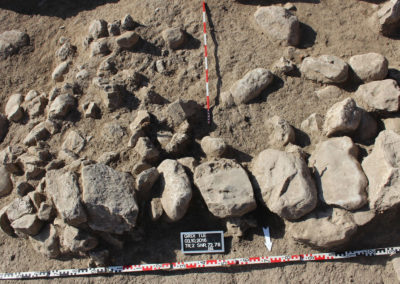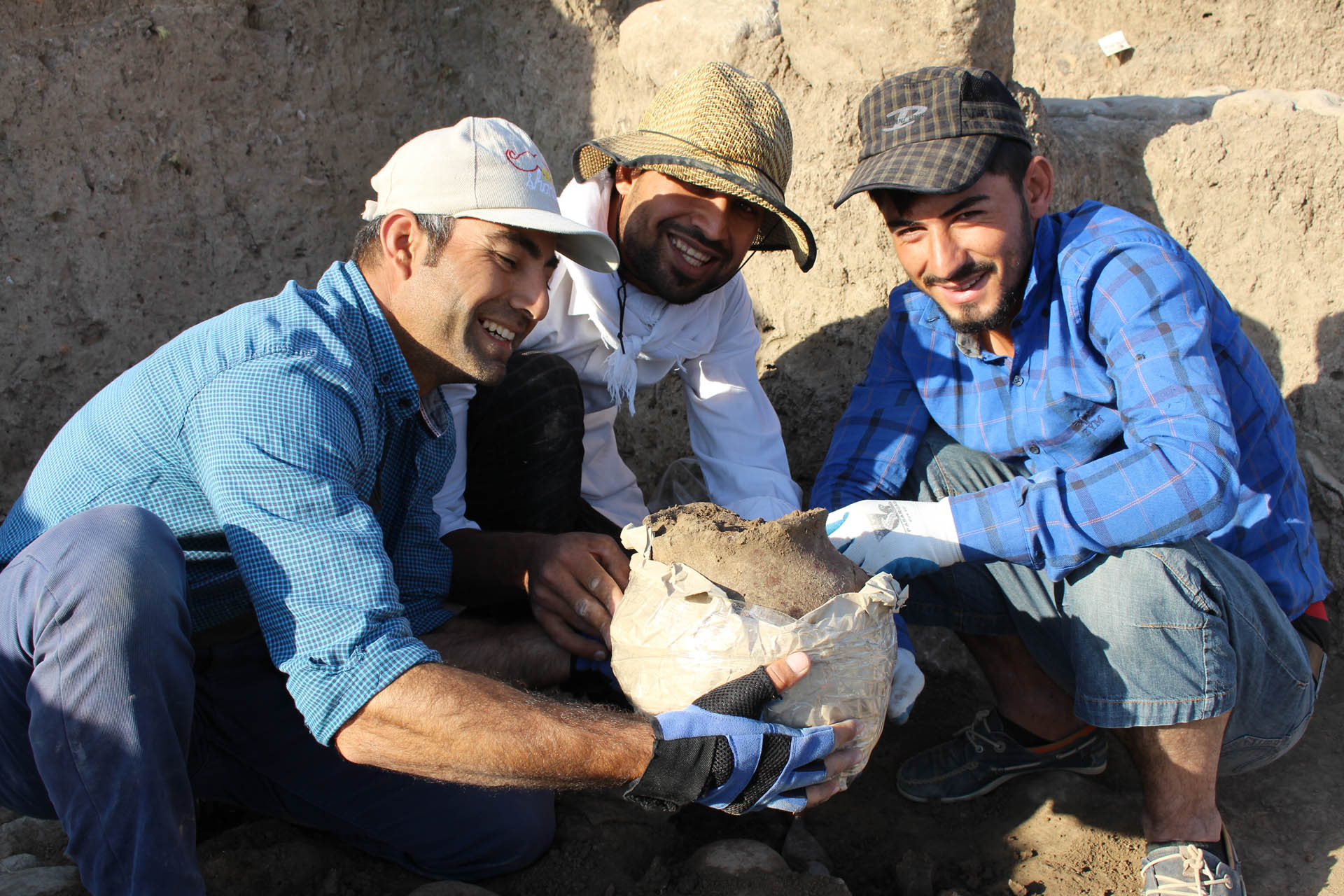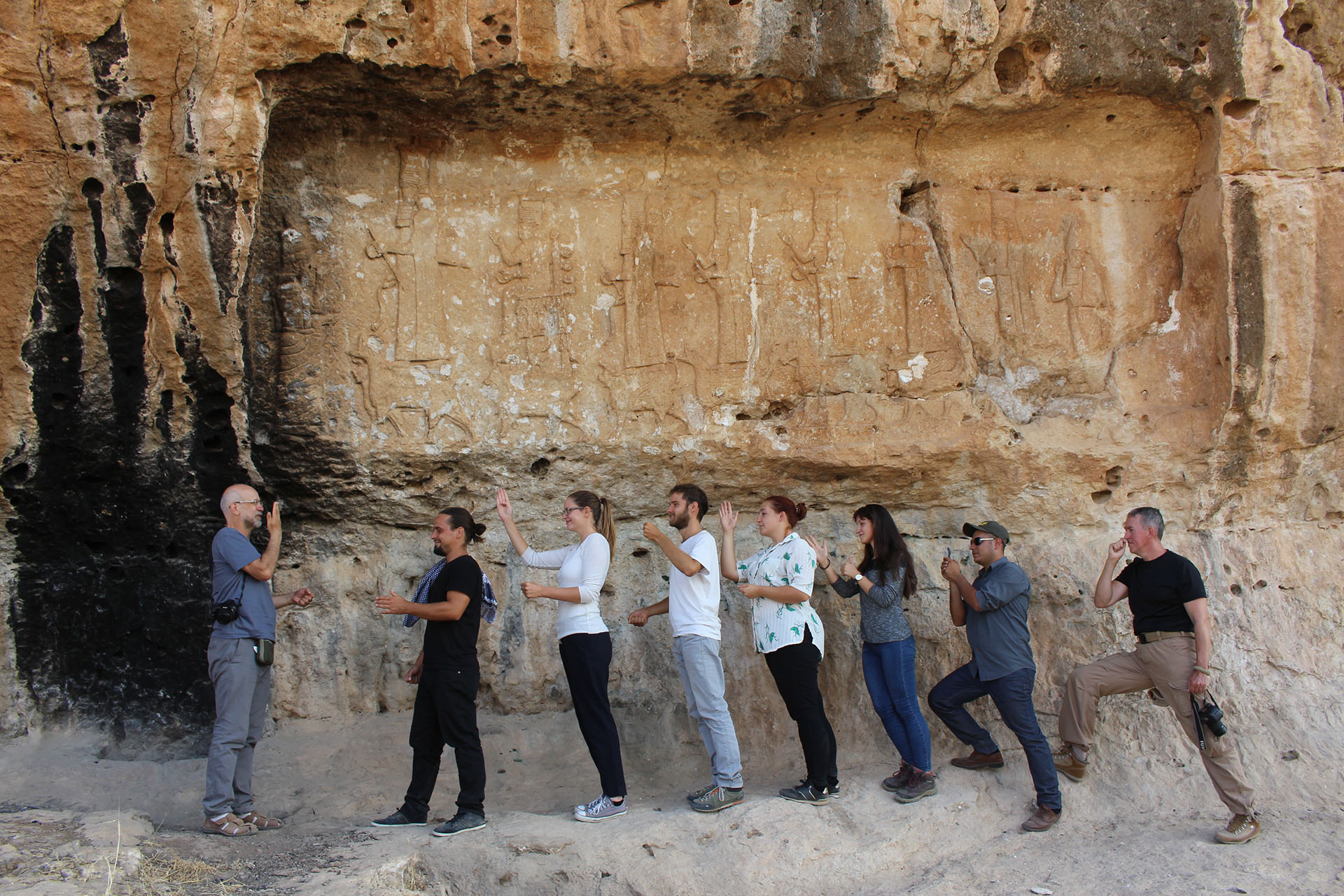Grd-i Tle - temető feltárása a plató keleti felszínén
Grd-i Tle településdombján már az első ásatási évad során kőrakásos sírokat tártak fel az ELTE munkatársai Iraki Kurdisztánban. A 22 sírból mindössze négy felnőtt maradványai kerültek elő, az összes többi temetkezés gyermekek és újszülöttek csontjait rejtette.
Bemutatás
During the first season of the Hungarian Archaeological Mission of Eötvös Loránd University, Budapest at Kurdistan (Iraq) a spot with dimensions of 4 × 4 m was opened on the edge of the eastern plateau of Grd-i Tle (850-480-SE). Almost immediately under the surface a number of closely located cist graves (in stone-built coffins) have been discovered. Among the altogether 22 burials only four were adults, the rest belonged to new-borns and infants, and to small children. The adult graves were dug down deeper and laid in greater distance from each other. The infant graves were, so to say, filled the remaining space between them, and laid directly below the surface. In consequence, the edge of the plateau was almost completely covered with infant burials, the stones of which are still visible on the surface of the entire plateau. Due to the absence of grave goods, the exact dating of the cemetery is not yet possible, however, however, in all likelihood it can be dated to sometime between the Parthian-Seleucid period and the age of the late medieval fortification complex.
A temető leírása
At the edge of the eastern plateau of the tell of Grd-i Tle a spot with dimensions 4×4 m (850-480-SE) was opened to verify the presence of phases preceded the “Islamic period”. Almost immediately under the surface a number of closely located cist graves (in stone-built cofins) have been discovered. Among the altogether 22 burials only four were adults, the rest belonged to new-borns and infants, and to small children.
The adult graves were dug down deeper and laid in greater distance from each other. The infant graves were, so to say, filled the remaining space between them, and laid directly below the surface. In consequence, the edge of the plateau was almost completely covered with infant burials, the stones of which are still visible on the surface of the entire plateau.
The burial process can be well reconstructed. The inner walls of the dug-out burial pit were coated by stones of various forms and sizes, the executors re-used every source material at their disposal, that is, the stones from the earlier walls of the settlement. In general, they intended to construct grave caskets with a largely rectangular inner space, although in many cases they strayed from this practice. Usually there was only just enough room for the body. The space between the casket and the walls of the gravel pit was, at many times, filled with stones, perhaps in order to stabilize the stone slabs. Although it is far from apparent in every grave, at some cases it seems obvious that before the covering of the casket the grave was filled with earth. The covering was consisted of larger, fiat stones: in case of infants, usually a single slab proved to be enough, while the caskets of the adult graves were covered by pieces of various forms, sometimes even roundish stones were used. The stones were used in unfinished form, that is, as they were found.
All of the graves were orientated W–E, the heads of the deceased were turned towards south. In the case of infants, the bodies were laid to rest on the right side with drawn up legs. The adults were laid on their back in a fiexed position, only the legs and the torso were turned right so that the face could face towards south.
One burial (grave No. 23.) represents a slightly difierent ritual from the above described one. Here no grave casket was constructed, the deceased was laid to rest directly in the burial pit.
Due to the absence of grave goods, the exact dating of the cemetery is not yet possible, however, however, in all likelihood it can be dated to sometime between the Parthian-Seleucid period and the age of the late medieval fortification complex.
Grave No. 1. (SNR 53)
Outer measurements of the grave casket: 0.65 × 0.4 m Inner measurements: 0.52 m × 0.2 m Depth: 0.25 m. The grave was situated directly below the surface, next to the southern trench wall. Its orientation is approximately W–E. The longer side walls were consisted of two, while the shorter walls were consisted of one limestone blocks, respectively. The western side of the grave shaft adjoined with the eastern wall of the deeper laying grave No. 10. Among the covering stones, altogether three were found in situ, a larger and two smaller ones. The position of the smaller stones suggests that the grave casket, made from stones, was filled with earth after the deposition of the body and that the covering slabs were put only later to their place. The earth filling contained several ceramic fragments. The approximately 45 cm long skeleton of the infant completely filled the inner space of the casket. The body was laid on the right side with drawn up legs and head turned south. Due to the proximity of the surface the recovered bones were in poorly preserved condition and were rather fragile. No grave goodswere present.
Grave No. 2. (SNR 54)
Outer measurements of the grave casket: 0.80 × 0.45 m Inner measurements: 0.49 m × 0.2 m Depth: 0.2 m. The grave was situated directly below the surface, and was orientated approximatelyW–E. The grave casket was consisted of four larger and several smaller, irregular shaped limestone blocks, the inner space was by and large rectangular, while it’s outer perimeter remained irregular. The position of the smaller stones suggests that the casket was constructed within a gravel pit. Here the covering slabs were not found in their original places.
Due to the proximity of the surface the recovered bones of the infant were in poorly preserved condition, only the skull, the pelvis, and the longer bones were preserved, however, it is clear that the body was laid on the right side, orientated west—east, with head turned south. No grave goods were present. The filling of the grave contained several ceramic fragments.
Grave No. 3. (SNR 55)
Outer measurements of the grave casket: 1.00 × 0.45 m Inner measurements: 0.65 × 0.28/0.15 m Depth: 0.38 m. The grave was situated directly below the surface, and was orientated approximately W–E. The longer sides of the casket were consisted of two fiat stone slabs, respectively, standing on their shorter edge. Since the slabs of the eastern side were wider, the inner space became quite narrow. At the north-western part two stone blocks were placed upon each other and thus the casket became almost twice as deep as that of the other similar, smaller sized graves. The western side was consisted of one stone block, while several blocks constituted the eastern, shorter side. Here the space between the slabs and the wall of the gravel pit was filled with smaller stones as well. The wider part of the western side was covered by a larger (0.70 × 0.36 m), while the narrower part by a smaller (0.30 × 0.24 m) fiat stone slab, respectively.
The skeletal remains of the W-E orientated infant, presumably laid to rest on the right side, were found in extremely poor state of preservation. No grave goods were present, the filling contained several ceramic fragments. It is likely, however, that the casket was originally made for a larger sized adult and thus its eastern part remained empty.
Grave No. 4. (SNR 56)
Outer size of the grave casket: 0.40 × 0.44 m Inner size: 0.30 × 0.20 m Depth: 0.26 m. The grave, situated at the western side of the trench could only be partly excavated as at least the half of it extended beyond the edge of the trench. The grave casket was partly consisted of stones and of a rectangular pavement brick, standing on its shorter edge, at the southern side. The grave casket was covered with stone slabs among which the middle one was still visible in the trench wall.
Since, as compared to the other infant burials, grave No. 4. was uncovered deeper below the present day surface, the skeletal remains were quite well preserved. Although only the feet bones appeared in the trench, their position suggests a west-east orientation, as well as in the case of the other infant burials. The body was laid to rest on the right side. No grave goods were present.
Grave No. 5. (SNR 57)
Outer measurements of the grave casket: 0.80 × 0.55 m Inner measurements: 0.5 m × 0,20/0.15 m Depth: 0.28 m. The grave laid directly below the surface. The grave casket was consisted of four large stone blocks, it’s inner configuration represents an irregular, oblong shape, while the outer perimeter was irregular, as well. Size of the stones lying lengthwise: 0.55 × 0.27 × 0.5 m and 0,47 × 0,23 × 0.15 m. The stone or stones which originally covered the casket were not preserved.
The skeletal remains were in poorly preserved state. On the basis of the size of the grave casket and of the bones, respectively, grave No. 5. may have been an infant burial as well, although the way of deposition cannot be determined, only the usual, W–E orientation of the body.
Grave No. 6. (SNR 58)
Infant burial. Outer measurements of the grave casket: 0.63 × 0.31 m Inner measurements: 0.45 × 0.15/0.10 m Depth: 0.14 m. The casket of grave No. 6., lying directly beneath the surface, was consisted of two stone slabs at the longer sides, respectively, while one, thick and fiatter, vertically positioned slab constituted each of the shorter sides, thus the inner space represents a trapezoid shape. There was only just enough room for the skull of the infant at the narrower western side. The space between the wall of the burial pit and the stone casket was filled with smaller stones. The grave was covered by three stone slabs of irregular shape.
In spite of the poor state of preservation of most part of the bones of the infant the skeleton was almost complete. Similarly to the others, it was laid on the right side, orientated west–east, with head turned south. No grave goods were present.
Grave No. 7. (SNR 59)
Infant burial. Outer measurements of the grave casket: 0.70 × 0.32 m Inner measurements: 0.50 × 0.14 m Depth: 0.25 m. The grave laid directly below the surface, the grave casket was consisted of two stones at the lengthwise sides and one at the shorter sides, respectively. Thus, because of the disparateness of the eastern side, the space created inside the casket was all but rectangular. It was covered with several separate stones among which only a single, unusually fiat one was preserved at the eastern side (Fig. 4).
Most part of the buried infant was revealed, although in poorly preserved state. Yet, the westeast orientated crouched position of the body was still visible. The body was laid on its right side with head turned south. The grave goods were absent as well. At the southern side of the stone casket a Greek Hellenistic silver tetradrachm was found in the earth filling of the burial pit, which may date the layer into which the graves were cut.
Grave No. 8. (SNR 60)
Child burial. Outer measurements of the grave casket: 1.00 × 0.50 m Inner measurements: 0.70 × 0.21 m Depth: 0.30 m. The grave laid at the NW corner of the trench, deeper below the surface. The grave casket was consisted of stones of varying size and represents an irregular inner shape. One of the lengthwise sides was paved with a row of three, while the other with two stones, it’s eastern side, however, was largely narrowed because of it’s closing by means of a slant stone slab.
Only a single stone remained from the covering. The small child – without proper anthropological investigation only estimated to be 1–2 years old – was laying on the right side in a crouched position, orientated west–east with head turned south. No grave goods were present.
Grave No. 9. (SNR 61)
Adult burial. Outer measurements of the grave casket: 2.25 m × 0.65 Inner measurements: 1.95 m × 0.23–0.30 m Depth: 0.40 m. The casket of the grave, lying at the NE side of the trench, was consisted of several, relatively small (0.15–0.30 m) stones of various form, and at some parts it was paved with two rows of stones, therefore the inner space represents an irregular shape. The executors adjusted themselves to the slope of the surface during the digging of the grave and thus the inner space slopes towards east as well. The space between the casket and the edge of the gravel pit was filled with smaller stones. The casket was covered by numerous, seven larger and many smaller slabs and roundish stones.
The body of the W-E orientated adult, laid to rest on his back, was – so to say – wedged into the narrow space. The legs and the upper part of the body were turned rightwards so that the head might front towards south. The bones were found in a fair state of preservation. No grave goods were present; the ceramics of the filling may originate from earlier layers.
Grave No. 10. (SNR 62)
Adult burial. Outer measurements of the grave casket: 1.20 × 0.54 m Inner measurements: 1.05 × 0.36 m Depth: 0.39 m. Only half of the grave, situated at the SW corner of the excavated area, appeared in the trench. The pit was dug deeper than that of the infant graves, approximately 1 m below the once surface level. The grave casket was constructed by and large regularly and was consisted of fiat stones of similar size. The side walls of the excavated part were coated by 0.25, 0.40, 0.50and 0.70 m long stone slabs which were complemented with smaller ones, while the shorter side was closed with a single stone. The walls of the casket were not outright vertical, their upper part inclined slightly outwards at the eastern part, and inwards at the western part which remained in the trench wall. The covering was consisted of several large, fiat stones, the smaller ones, however, placed at the ending, imply that they were put in place after the filling of the gravel pit .
Only a part of the well preserved skeleton appeared in the trench, from under the pelvic bones. On the basis of the position of the feet the deposition of the body may have been similar to that of grave No. 9., the deceased was laying on his back in extended position, orientating west–east, with head turned south (Fig. 6). No grave goods were present, the large amount of ceramics of the filling may originate from earlier layers.
Grave (?) No. 11. (SNR 63)
Outer measurements of the grave casket: 10.50 × 0.58 m Inner measurements: 0.60 × 0.50 Depth: uncertain. Perhaps a disturbed infant grave. The atypical stone construction which may have contained a burial was situated at the NE part of the trench, directly below the surface. It’s longer northern side remained in the unexcavated area. Certain stones of the construction were already visible on the surface. Although it’s axis represents W-E orientation, the inner space was of an oval shape and thus, on the whole, it remarkably difiers from the other burials. During the shaping of this construction the smaller stones were placed rather distant from each other. It was heavily disturbed and only a few human bones were found at the inside, and an additional skull from the area between the latter and grave No. 15. To sum up, it cannot be ascertained that it was a grave at all. The unusually large amounts of ceramics from the filling may originate from earlier layers.
Grave No. 12. (SNR 65)
Infant burial. Outer measurements of the grave casket: 0.60 × 0.28 m Inner measurements: 0.50 × 0.14 m Depth: 0.15 m. The grave was obviously wedged into the empty space between the formerly constructed graves Nos. 2. and 3., by the use of smaller stones during its construction. Four stones were placed at the southern side, while the eastern side was constructed by means of complementing one stone of grave No. 3. with two additional stones. The western, shorter side was closed with a stone, the corresponding stone of the eastern side had not been preserved. On the basis of the form and location of the stones it seems obvious that the walls of a formerly dug gravel pit were coated by stones. It was covered with a single fiat stone. The skeletal remains of the buried infant were in poor state of preservation. In spite of the scantly preserved bones it is clear that the body was laid on the right side, orientated west—east, with head turned south. No grave goods were present.
Grave No. 13. (SNR 66)
Partially destroyed infant burial. Outer measurements of the grave casket: 0.32 × 0.30 Inner measurements: 0.20 × 0.12 Depth: 0.22 mpart survived. The lengthwise sidesmay have been consisted of several stones. The preserved ones were of unequal height and thus the single remaining covering slab was found in slant position. The extant part of the grave contained an infant skeleton in poorly preserved state. Here, the body was laid on the right side as well, orientated west—east, with head turned south. No grave goods were present.
Grave No. 14. (SNR 68)
Adult grave. The grave casket was absent. Only the smaller part of this grave, lying approximately 0.45 m below the surface, was unearthed, the other part, above the thigh bones of the deceased, remained inside the unexcavated area. It seems that a grave casket wasn’t even originally present, the stones lying in the vicinity of the skeleton were too small for such a construction. The bones of the legs, appearing in the trench, clearly show that the body was laid to rest on the right side, with the right knee drawn up. The deposition of the body may have been similar to that of grave 23., although the latter belonged to an earlier period (Fig. 7). No grave goods were present; the single iron object may have originated from the filling.
Grave No. 15. (SNR 69)
Child grave. Outer measurements of the damaged grave casket: 1.20 × 0.53 m Inner measurements: 0.90 × 0.25 m Depth: 0.24 m. The grave was situated at the eastern part of the trench, directly below the escarpment under the surface. Several stones which originally constituted the grave casket may have laid above the surface and thus they were not present in their original place any more. According to the construction of the surviving northern part the longer sides may have consisted of three stones, respectively, while single stones may have closed the shorter sides. By and large, the casket represents a slightly trapezoid shape. The smaller stones, placed between the casket and the wall of the gravel pit were also observable here. The bones were disturbed by animal burrowing, however, the remaining parts suggest that the deposition was correspondent with that of the other infant burials, that is, the body was orientated W–E, with head turned south. No grave goods were present.
Grave No. 16. (SNR 70)
Child grave. Partially preserved grave casket. The grave was situated at the eastern part of the trench, directly below the escarpment under the surface. Only a single stone of the norther side of the casket was preserved, on the basis of which the depth of the grave was 0.28 m. The legs of the poorly preserved infant skeleton were disturbed by animal burrowing. This body was orientated W–E as well, laid to rest on the right side in crouched position. However, the head wasn’t turned towards south in here, although this may have resulted from later dislocation. No grave goods were present.
Grave No. 17. (SNR 71)
Child grave. Outer measurements of the damaged grave casket: 1.00 × 0.50 m Inner measurements: 0.82 × 0.22 m Depth: 0.24 m. The grave was situated at the eastern part of the trench as well, directly below the escarpment under the surface. The eastern part of the grave casket was destroyed by erosion. The preserved part represents a trapezoid shape, the northern longer side was consisted of three stones, two of which survived, while three were present from the four stones which constituted the southern, longer side. The bones were heavily disturbed by animal burrowing and were scattered. Thus the mode of deposition cannot be ascertained, we can only suppose that it may have been similar to that of the other infant and child graves. No grave goods were present.
[Grave No. 18. (SNR 72)]
An oval stone construction, approximately 0.80 m in diameter with unknown function. It was built of several smaller and larger stones. Although initially it seemed to be a grave it did not contain human remains, nor an empty space within its inner part. Perhaps it may have been the foundation of a platform. It is contemporaneous with grave No. 23. which predates most of the other graves (see below).
Grave No. 19. (SNR 73) = Grave No. 11?
Skull of a small child. Separate skull found next to grave No. 11., and presumably originates from the latter.
Grave No. 20. (SNR 75)
Child grave. The grave casket was destroyed. The grave was found under graves Nos. 1. and 2., at the southern wall of the trench. The grave casket was largely destroyed, only a few stones were preserved, although not in their original position. The body of the small child was laid on the right side, orientated west—east, with head turned south. No grave goods were present.
Grave No. 21. (SNR 76)
Partially preserved child grave. The grave, situated at the edge of the escarpment, was almost completely destroyed, only a skull, laid on the right side and fronted towards south, was preserved.
Grave No. 22. (SNR 77)
Grave of a small child. Outer measurements of the damaged grave casket: 0.78 × 0.35 m Inner measurements: 0.45 × 0.11 m Depth: 0.15 m. The eastern side of the casket of the grave, lying at the NE corner of the trench inside the escarpment, was destroyed by erosion, only a few stones were preserved, although part of them were not in their original position. The skeletal remains were in a poor state of preservation. The shape of the casket and the position of the remaining bones suggest an obvious W-E orientation. We can only suppose that the body was laid to rest on the right side. No grave goods were present.
Grave No. 23. (SNR 84)
Adult grave. This grave belongs to the earliest phase of the medieval cemetery. It was situated at the middle area of the trench and was cut next to an earlier wall from the Hellenistic–Parthian period. The funerary ritual difiers from the later practice, no stone casket was present, the deceased was laid to rest in a shallow burial pit and consequently the latter was covered by longish, narrow stones which were put across. In this case, seven larger stones were used (Fig. 8). The burial pit did not represent a regular rectangular shape, rather, it was adjusted to the shape of the body and thus it was slightly cambered. Unlike in the case of later adult graves here the whole body was laid to rest on the right side with head towards south (Fig. 9). The bones were well preserved. Consequent to the deposition of the body an oval stone construction, 0.80 m in diameter, was built (SNR 72, formerly grave No. 18), which covered the feet. Thereupon the construction was covered with two larger stones. The proper function of the oval stone construction is unknown. No grave goods were present.
Munkatársak 2016
Dr. Dezső Tamás
ásatásvezető
Dr. Kalla Gábor
ásatásvezető
Barzan Baiz Ismail
régész felügyelő
Kamal Rasheed
régész felügyelő
Dr. Mordovin Maxim
régész
Masek Zsófia
régész
szabó Nóra
régészhallgató
Ardalan Khwsnaw
régészhallgató
Aram Ali Hama Amin
régészhallgató
Weisz Attila
geodézia
sándor Lajos
fémdetektor

